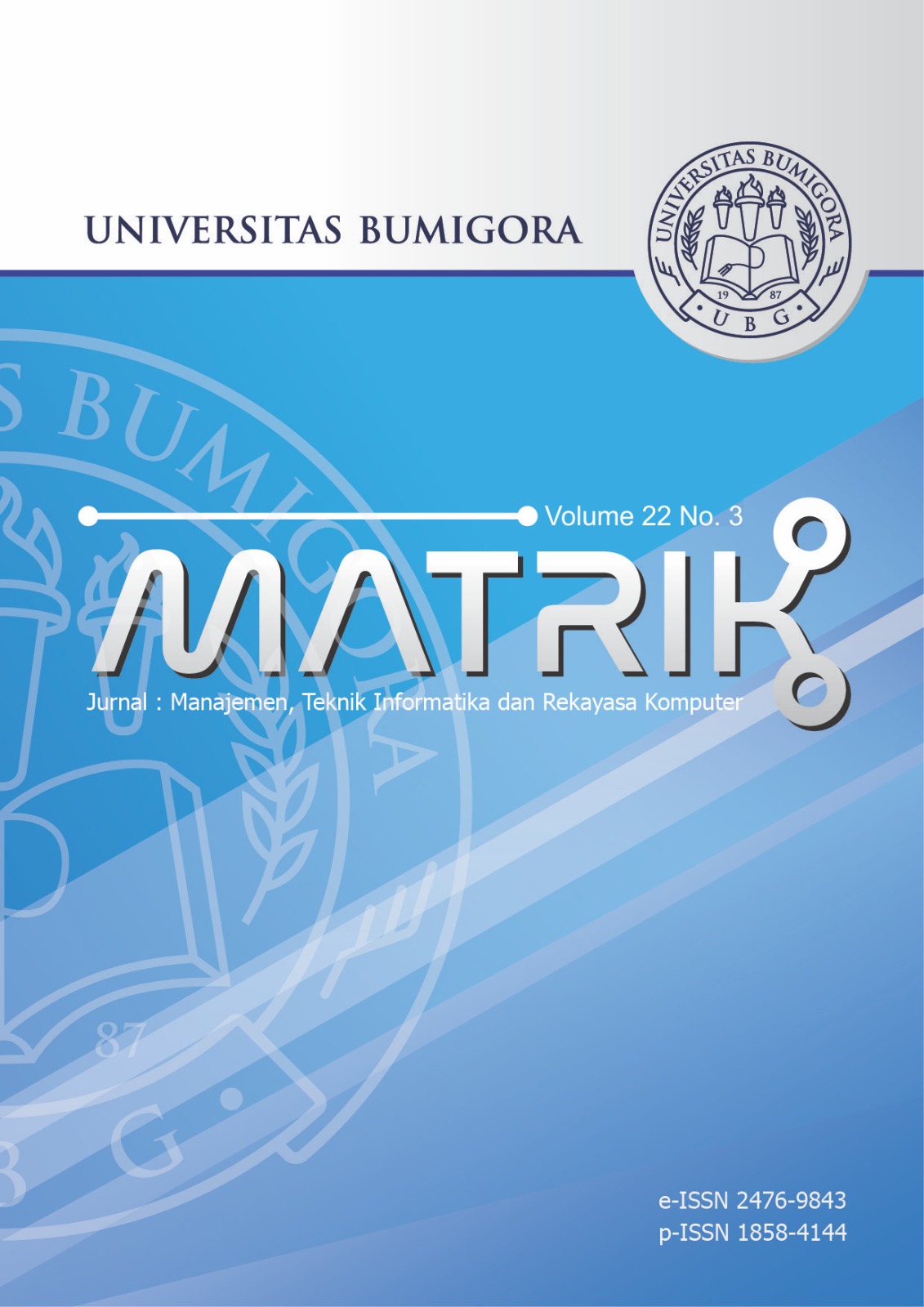Digital Forensic Analysis of WhatsApp Business Applications on Android-Based Smartphones Using NIST
DOI:
https://doi.org/10.30812/matrik.v22i3.3033Keywords:
Android, Digital Evidence, Digital Forensics, MOBILedit, National Institute of Standards and Technology, WhatsApp BusinessAbstract
WhatsApp Business is an Android application that can be downloaded on Playstore to serve small business owners. This provides an opportunity for criminals to take advantage of the app’s features. These crimes can take the form of fraud, misdirection, and misuse of applications, so digital forensics is necessary because there has never been any research that has done this. This study aims to obtain digital evidence and is carried out on Android smartphones with the WhatsApp Business application installed with four scenarios tested. This study uses the NIST SP 800-101 Rev 1 guidelines with four stages: preservation, acquisition, inspection & analysis, and reporting. The forensic method used is static forensics using the MOBILedit forensic express forensic tools and SysTools SQLite Viewer. The results of this study in scenario 1, by not deleting, get a 100% percentage. Then, scenario 2, namely direct write-off, gets a percentage of 71%. Furthermore, scenario 3, namely uninstalling the application, does not get digital evidence, and scenario 4, namely deleting data through the application manager, also does not get any evidence. The contribution of this research is expected to be a reference in uncovering cases in the WhatsApp Business application with digital forensics.
Downloads
References
[2] D. Curry, “Android Statistics (2022),†BusinessofApps, 2022. https://www.businessofapps.com/data/android-statistics/ (accessed Dec. 19, 2022).
[3] WhatsApp, “Apa Itu Aplikasi WhatsApp Business?†https://faq.whatsapp.com/641572844337957/?locale=id_ID (accessed Apr. 01, 2023).
[4] D. Astria, M. Santi, and S. Muhammadiyah Tulungagung, “Pemanfaatan Aplikasi Whatsapp Bisnis Dalam Strategi Pemasaran Online Untuk Meningkatkan Jumlah Penjualan,†Tulungagung, Dec. 2021. [Online]. Available: http://ejournal.staim-tulungagung.ac.id/index.php/Eksyar
[5] L. Ceci, “Number of WhatsApp Business downloads worldwide from 2018 to 2021 (in millions),†Statista, Jan. 2023, Accessed: Apr. 01, 2023. [Online]. Available: https://www.statista.com/statistics/1305771/whatsapp-business-downloads-worldwide/
[6] Stephanie Chevalier, “Countries with the highest number of WhatsApp Business app downloads as of June 2022(in millions),†Statista, Jan. 27, 2023. https://www.statista.com/statistics/1276030/whatsapp-business-downloads-leading-countries/ (accessed Apr. 01, 2023).
[7] Raymond SM Tampubolon and Akhmad Zaenuddin, “Status Hukum Interaksi Bisnis Melalui WhatsApp,†KABAR24, Nov. 09, 2020. https://kabar24.bisnis.com/read/20201109/16/1315273/status-hukum-interaksi-bisnis-melalui-whatsapp (accessed Apr. 01, 2023).
[8] Mohammad Faruq Afif, “Metode Clustering Storage untuk Penyimpanan Bukti Digital Menggunakan Software Defined Storage,†Universitas Islam Indonesia, Oct. 16, 2019. https://dspace.uii.ac.id/handle/123456789/18258 (accessed Apr. 01, 2023).
[9] R. Tamma, O. Skulkin, H. Mahalik, and S. Bommisetty, “Practical Mobile Forensics: Forensically investigate and analyze iOS, Android, and Windows 10 devices,†2014.
[10] ANGGIS TIYANA BR SITUNGKIR, “Tinjauan Yuridis Terhadap Digital Forensik Dalam Menganalisis Barang Bukti Digital Dalam Pembuktian Tindak Pidana Ditinjau Dari Undang-Undang No 11 Tahun 2008 Junto Undang-Undang No 19 Tahun 2016 Tentang Informasi Dan Transaksi Elektronik,†2018.
[11] H. Arshad, A. Bin Jantan, and O. I. Abiodun, “Digital forensics: Review of issues in scientific validation of digital evidence,†Journal of Information Processing Systems, vol. 14, no. 2, pp. 346–376, 2018, doi: 10.3745/JIPS.03.0095.
[12] X. Zhang, K.-K. Raymond, and C. Editors, “Forensic Education An Experiential Learning Approach,†2019. Accessed: Dec. 11, 2022. [Online]. Available: http://www.springer.com/series/11970
[13] M. N. Al-Azhar, “Digital Forensic,†Jakarta: Puslabfor Bareskim Polri, 2012.
[14] R. Stoykova, “Digital evidence: Unaddressed threats to fairness and the presumption of innocence,†Computer Law and Security Review, vol. 42, Sep. 2021, doi: 10.1016/j.clsr.2021.105575.
[15] M. S. Jafri, S. Raharjo, and M. R. Arief, “Implementation of ACPO Framework for Digital Evidence Acquisition in Smartphones,†vol. 15, no. 1, 2022.
[16] R. Ayers, S. Brothers, and W. Jansen, “Guidelines on mobile device forensics,†Gaithersburg, MD, May 2014. doi: 10.6028/NIST.SP.800-101r1.
[17] A. Yudhana, “Perbandingan Tool Forensik pada Mozilla Firefox Private Mode Menggunakan Metode NIST.†[Online]. Available: http://jurnal.itg.ac.id/
[18] I. Riadi, “PERBANDINGAN TOOL FORENSIK DATA RECOVERY BERBASIS ANDROID MENGGUNAKAN METODE NIST,†Jurnal Teknologi Informasi dan Ilmu Komputer (JTIIK), vol. 7, no. 1, pp. 197–204, 2020, doi: 10.25126/jtiik.202071921.
[19] M. Dweikat, D. Eleyan, and A. Eleyan, “Digital Forensic Tools Used in Analyzing Cybercrime,†Journal of University of Shanghai for Science and Technology, vol. 23, no. 3, Mar. 2021, doi: 10.51201/Jusst12621.
[20] A. N. Ichsan and I. Riadi, “Mobile Forensic on Android-based IMO Messenger Services using Digital Forensic Research Workshop (DFRWS) Method,†Int J Comput Appl, vol. 174, no. 18, pp. 34–40, Feb. 2021, doi: 10.5120/ijca2021921076.
[21] I. Riadi, H. Herman, and N. H. Siregar, “Mobile Forensic of Vaccine Hoaxes on Signal Messenger using DFRWS Framework,†MATRIK : Jurnal Manajemen, Teknik Informatika dan Rekayasa Komputer, vol. 21, no. 3, pp. 489–502, Jul. 2022, doi: 10.30812/matrik.v21i3.1620.
[22] K.D.O Mahendra and I.K.A Mogi, “Digital Forensic Analysis of Michat Applications on Android as Digital Proof in Handling Online Prostitution Cases,†Jurnal Elektronik Ilmu Komputer Udayana , vol. Volume 9 No. 3, 2021.
[23] Ltd. SysTools Software Pvt, “SysTools SQLite Viewer.†https://www.systoolsgroup.com/sqlite-viewer.html (accessed Dec. 17, 2022).
Downloads
Published
Issue
Section
How to Cite
Similar Articles
- Romi Choirudin, Ahmat Adil, Implementasi Rest Api Web Service dalam Membangun Aplikasi Multiplatform untuk Usaha Jasa , MATRIK : Jurnal Manajemen, Teknik Informatika dan Rekayasa Komputer: Vol. 18 No. 2 (2019)
- sri suharti, Anton Yudhana, Imam Riadi, Forensik Jaringan DDoS menggunakan Metode ADDIE dan HIDS pada Sistem Operasi Proprietary , MATRIK : Jurnal Manajemen, Teknik Informatika dan Rekayasa Komputer: Vol. 21 No. 3 (2022)
- Syafri Arlis, Muhammad Reza Putra, Musli Yanto, Improved Image Segmentation using Adaptive Threshold Morphology on CT-Scan Images for Brain Tumor Detection , MATRIK : Jurnal Manajemen, Teknik Informatika dan Rekayasa Komputer: Vol. 23 No. 3 (2024)
- Angelina Ervina Jeanette Egeten, Siska A. Damanik, Ika Agustina, Marcelina Panggabean, Perancangan Sistem Informasi Posyandu Berbasis Web Pada Yayasan Kalyanamitra Di Jakarta Timur Untuk Mendukung Program Bidang Pendampingan Komunitas , MATRIK : Jurnal Manajemen, Teknik Informatika dan Rekayasa Komputer: Vol. 18 No. 2 (2019)
- Heru Pramono Hadi, Eko Hari Rachmawanto, Rabei Raad Ali, Comparison of DenseNet-121 and MobileNet for Coral Reef Classification , MATRIK : Jurnal Manajemen, Teknik Informatika dan Rekayasa Komputer: Vol. 23 No. 2 (2024)
- Fiby Nur Afiana, Pungkas Subarkah, A. Kholil Hidayat, Analisis Perbandingan Metode TAM dan Metode UTAUT 2 dalam Mengukur Kesuksesan Penerapan SIMRS pada Rumah Sakit Wijaya Kusuma DKT Purwokerto , MATRIK : Jurnal Manajemen, Teknik Informatika dan Rekayasa Komputer: Vol. 19 No. 1 (2019)
- M. Khairul anam, Esi Tri Emerlada, Susi Erlinda, Tashid Tashid, Torkis Nasution, The Application of Usability Testing to Analyze the Quality of Android-Based Acupressure Smart Chair Applications , MATRIK : Jurnal Manajemen, Teknik Informatika dan Rekayasa Komputer: Vol. 22 No. 2 (2023)
- Tjut Awaliyah Zuraiyah, Sufiatul Maryana, Asep Kohar, Automatic Door Access Model Based on Face Recognition using Convolutional Neural Network , MATRIK : Jurnal Manajemen, Teknik Informatika dan Rekayasa Komputer: Vol. 22 No. 1 (2022)
- Imam Fahrur Rozi, Ahmadi Yuli Ananta, Endah Septa Sintiya, Astrifidha Rahma Amalia, Yuri Ariyanto, Arin Kistia Nugraeni, Analyzing the Application of Optical Character Recognition: A Case Study in International Standard Book Number Detection , MATRIK : Jurnal Manajemen, Teknik Informatika dan Rekayasa Komputer: Vol. 24 No. 2 (2025)
You may also start an advanced similarity search for this article.


.png)












